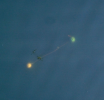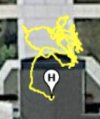- Joined
- Apr 12, 2018
- Messages
- 66
- Reactions
- 21
- Age
- 80
I need to know if the cameras forward view stays pointed in a specific direction when it has to compensate for changing side winds when it is on its way to a GPS waypoint.
In other words does it compensate for changing side winds exclusively with ROLE keeping the camera pointed at its target?
These are two buoys 8 feet feet below the surface of a lake, attached to a 4 foot horizontal spreader.
This image was from a flyover straight from my location over the location of buoys with 0 wind. I need to know if orientation of the buoys as it appears from the straight down view of the camera will be the same if the there is a slight west breeze or a slight east breeze ? I am hoping the cameras looks straight at it its GPS target and not YAW left and right with the breeze.
What's this about ? Its about a submersible Slalom Course. I am hoping this orientation of these buoys changes in the next 6 months. Without a boat between now and May 2022, the drone is my only way to inspect this pair of buoys 700 feet from shore.
These buoys are on a single rope that passes through a pulley 68 feet down. There is a twist in the rope and I need to get it untwisted. Its a puzzle because there is no way to know how to untwist it without diving and that's not easy to arrange. I am hoping the 4 foot spread at the top and 30 pounds of buoyancy will slowly unwind the twist over the next few months.

In other words does it compensate for changing side winds exclusively with ROLE keeping the camera pointed at its target?
These are two buoys 8 feet feet below the surface of a lake, attached to a 4 foot horizontal spreader.
This image was from a flyover straight from my location over the location of buoys with 0 wind. I need to know if orientation of the buoys as it appears from the straight down view of the camera will be the same if the there is a slight west breeze or a slight east breeze ? I am hoping the cameras looks straight at it its GPS target and not YAW left and right with the breeze.
What's this about ? Its about a submersible Slalom Course. I am hoping this orientation of these buoys changes in the next 6 months. Without a boat between now and May 2022, the drone is my only way to inspect this pair of buoys 700 feet from shore.
These buoys are on a single rope that passes through a pulley 68 feet down. There is a twist in the rope and I need to get it untwisted. Its a puzzle because there is no way to know how to untwist it without diving and that's not easy to arrange. I am hoping the 4 foot spread at the top and 30 pounds of buoyancy will slowly unwind the twist over the next few months.

Last edited:











